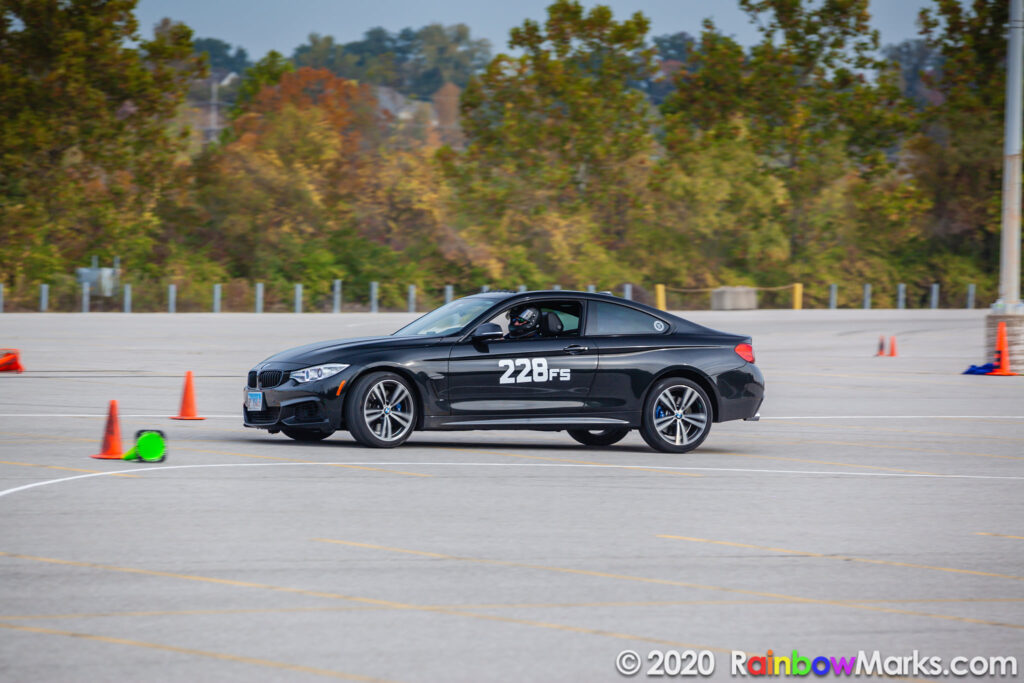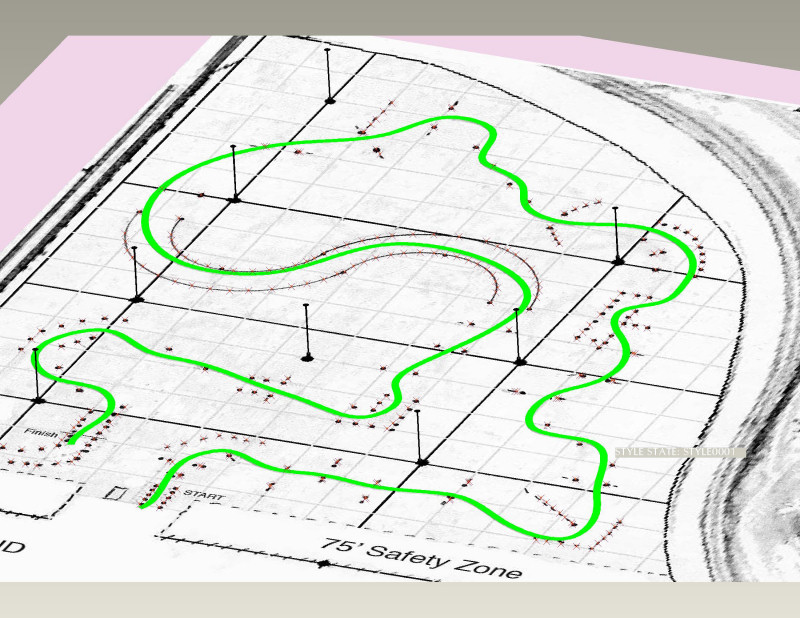
The sun breaks above the horizon to reveal a group of people groggily shuffling around a large arena parking lot. Some are busy applying numbers and inspecting their car, others are swapping out a set of wheels with sticky track tires, while some sip their morning coffee and look out across a sea of orange traffic cones. What brought out all these people at the crack of dawn? Autocross. One of the least known, but easiest and safest forms of amateur auto racing available today.
What is autocross?
Autocrossing is essentially a race against the clock. Cars run individually around a tight course marked with traffic cones as fast as possible. Clubs will build courses anywhere with a large, wide open, paved space with few obstacles. Most hosting organizations tend to run events in parking lots at stadiums, raceways, fair grounds, or large disused shopping malls.
When you see an autocross course for the first time, it looks like a sea of haphazardly scattered traffic cones. In reality the sea of cones marks a tight course of slaloms, obstacles, and gates. Below is an overhead drawing of an example course. The dots represent the cones.

Not only is speed important, but you don’t want to miss an element of the course or hit any cones. Missing a turn results the run not counting and hitting cones will result in a time penalty. The difficulty, length, and style of course are all depend on the size of the hosting venue and organization running the event. The number of runs you get typically depends on the number of participants and the event organizers ability to get safely get cars through the course.
One thing to note is these courses are not fast. You won’t hit tripple-digit speeds like you would at a track day or HPDE. Even on the longest courses it is highly unlikely you’ll get out of second gear and speeds almost never top 60 mph. Autocross is about car control skill and handling, not flat-out speed. There is a reason Mazda Miata’s and Toyota 86/Subaru BRZ’s are always at the top of the standings at most clubs.
Event Organizers
There are lots of organizations hosting events. I participate with my local Sports Car Club of America (SCCA) chapter, but national organizations like the National Auto Sports Association (NASA), BMW Car Club of America, and Porsche Club of America also host events. For readers not in the US, I unfortunately don’t know which sanctioning bodies are active in your area, but hope they aren’t too hard to find.
Depending on the popularity of autocrossing in your area, there may also be local clubs hosting events. Where I live there are at least two local clubs holding events. One is comprised of autocrossing fanatics from the local SCCA and NASA chapters who decided to establish their own organization and host events on weekends not already occupied by racing. Another was born out of a group of people who organized car shows and decided the next best step would be competitive events.
For anyone in the US, the best staring point to finding events is MotorsportReg. This site is the largest registry of motorsport events in the US and includes not only autocross, but also listings for rally, High Performance Driving Events (HPDE), and track day events. You can start searching with your zip code and then provide a distance to capture everything within a radius you’re willing to travel. SCCA and NASA chapters divide the US into regions and the region which covers the area where you live will have listings of events. For smaller local-based clubs, it will take a little digging on your part with our good friend Google.
I will offer one word of caution. Not all organizations hosting events are created equal. Some vary in quality and safety of their events. Typically, the national clubs, and especially those organized around motor racing like SCCA and NASA, will host the best events.
Bring any car
I can hear you asking now, “I need an expensive and fast sports car to do this, right”? Nope! Not at all. Anyone can participate in any type of car. The most important thing to the organizers of these events is safety, so any car in good working order and able to pass a brief inspection can run. Due to ride-height, a high center of gravity, and a very real threat of roll-over accidents, SUV’s and trucks are not allowed. At large events it isn’t uncommon to see dedicated race cars, exotic sports cars, classic American hot-rods, basic stock sedans and economy cars, and everything in between.
To keep things fair, classes divide cars into similar capabilities, sizes and types. A class-based handicap is applied to the final times in an effort to create a balance across all classes.
Unlike track days and HPDE’s, the wear and tear to your car will be minimal. Each run is only around 50 to 60 seconds (or much less as you gain experience) and the courses are not very long. You don’t have to wear about excessive brake wear, engine cooling problems, or many of the other stresses a car endures at a track. You may see accelerated tire wear if you attend events regularly, but it still won’t be like a track day were some heavier vehicles driven by experienced drives will wear out a set of tires in only a couple events. Any car in good working order can endure a season without any problems or needing to replace tires.
No experience necessary
Everyone at these events had a first day and most people will still remember it clearly.
Being a novice is not a bad thing
The SCCA goes out of it’s way to encourage new people trying the sport. I’m sure other organizers are the same. Each SCCA event has a Novice Chief and other people designated to help out any first-time participants and anyone with very little experience. They will answer any questions and will often be the ones leading the “Novice Walk” around the course before the event starts. Before the COVID-19 pandemic, experienced members in each run group were available to ride-along with any new people needing help. Hopefully ride-alongs will return soon. Even better there is a Novice class trophy at the end of the season for the best driver participating in their first season!
Age is just a number
Age and overall driving ability have nothing to do with participation either! Any driver holding a valid driver’s license, you’ll be allowed on course. I’ve seen drivers as young as 16 with a brand-new driver’s license, all the way to people in their 70’s. The objective is a fast run time, but everyone is there to have fun and be safe. No matter how fast or slow a person might be, people at these events are always encouraging, helpful, and friendly. They are having fun and they want everyone else there to enjoy themselves too! In stead of being judged for being too slow, you’ll most likely find people asking about your runs and offering suggestions to get a better time.
Don’t worry, you’ll be safe
I’ve said it before, but it’s worth mentioning here again. The first thing on everyone’s mind at these events is safety. No matter how slow you might be, or how big of a mistake you might make on course, you, other drivers, and those working on course are not in any danger. This is a very low risk environment where you can really challenge yourself regardless of your abilities.
Go race!
Interested in going out and pushing your driving ability and your car to it’s handling limits? Here are a few tips to get you moving in the right direction after you’ve signed up for an event
Get your car ready
- Air up your tires to the car maker’s recommended pressure and then add a little more to keep the tire from rolling over on the side wall in hard turns. Just don’t forget to put the pressure back where it belongs after you get home from the event
- Clean out ANY lose items. Anything lose in the cabin or trunk will become a missile while on course
- Check out the mechanical function of the car top to bottom. Make sure the brakes work well, tires have plenty of tread, all fluids are at the appropriate levels (and none of them are leaking), wheel lug nuts are torqued correctly, and in general everything is in good shape. Autocross isn’t stressful on a car like a track day, but you don’t want anything to fail.
Get a helmet
Many organizers will allow participants to wear motorcycle helmets which are far less expensive than those certified for auto racing events. Good event organizers will clearly state their helmet requirements regarding which certifications are allowed, which years of certification are still valid, and whether full face or open face are allowed. Pre- COVID-19 pandemic some organizers had a few helmets you could borrow. While this may be an option, I wouldn’t recommend it because there is no telling if they will have one which fits properly and who knows how well it was cleaned after the last person wore it in the sweltering summer heat. Yuck.
Get yourself ready.
- Find out the correct class for your car. Every organization is a little different, but SCCA and NASA publish rule books with classification guides. If your car is stock, classification is pretty easy. The real difficulty in classification will come if you made any modifications.
- Read up on things to bring to the event. Many organizations will have novice guides and/or contact information for people to ask questions. I always make sure to bring a hat, sunscreen, lunch, and plenty of water at a minimum. Also bring a roll of painter’s tape to mark the number and class on both sides of your car. If your car is dark in color use light color tape, if the car is light color use the blue tape. There is nothing worse than blue tape on a blue or black car for the course workers. Over time you’ll probably want to invest in magnetic numbers if you frequently participate in events.
- Have the right attitude. At your first event, you probably won’t be very fast. You’ll probably have a run or two be disqualified. You’ll plow over a few cones. Despite it all be positive, listen to the advice of the veterans and just focus on improving and having fun. Always remember the most unassuming person in the rattiest looking car may be the faster person at the event, so don’t get mad if they lay down much quicker times!
Final thoughts
So there it is. A quick overview of autocrossing. I’ve now run nearly two full seasons with my local SCCA chapter and have just started a third. I love it for how easy, inexpensive and low risk it is compared to other forms of racing and track days. It may not have the high speed thrills of a track day, but you’ll still learn the limits of you and your car while gaining car handling skills. Hopefully you’ll at least give one event a try, and maybe get hooked on it like I have. As the summer progresses, I will try to provide a few short updates on how the season is progressing.
